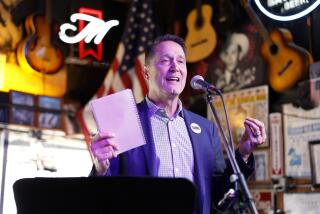First Amendment Protects Artists’ Darker Explorations
- Share via
Exploited by the likes of Dan Quayle and Ollie North, the distraught widow of a Texas state trooper who was tragically gunned down last April is suing rap artist Tupac Amaru Shakur and his record company because a homemade tape of one of the 400,000 copies of his latest album was found in the tape deck at the scene of the crime (“Testing the Limits,” Calendar, Oct. 13).
Quayle shamelessly tried to shore up his sagging reelection bid by inviting the slain officer’s daughter to accompany him during a recent campaign appearance in Houston, and North has offered to provide legal advice and expert testimony.
But it’s going to take a lot more than publicity-seeking right-wing zealots to keep Linda Sue Davidson’s ill-advised lawsuit alive. By now, a solid body of First Amendment precedent has firmly established that victims of crime cannot sue musicians, movie producers or writers for allegedly “inspiring” or “inciting” those crimes. Consider these court decisions:
* Just last week the U.S. Supreme Court refused to reinstate a pair of lawsuits that accused rock star Ozzy Osbourne of “inciting,” through his music, two teen-age suicides in Georgia and South Carolina.
* In 1988, a California appellate court upheld the dismissal of another lawsuit by the parents of a young man who killed himself while listening to Osbourne’s “Suicide Solution.” The court held that “musical lyrics and poetry cannot be construed to contain the requisite ‘call to action’ for the elementary reason that they simply are not intended to be and should not be read literally on their face, nor judged by a standard of prose oratory.”
The court added that “reasonable persons understand musical lyric and poetic conventions as the figurative expressions which they are. No rational person would or could believe otherwise nor would they mistake musical lyrics and poetry for literal commands or directives.”
* In 1979, a federal court in Florida threw out a case brought by Ronny Zamora, a 15-year-old who had killed an elderly neighbor and then tried to blame the three television networks for “stimulating, inciting and instigating” him to duplicate the crimes he had witnessed on hundreds of violent TV shows.
The court held that it is “an unfortunate fact that in our society there are people who will react violently to movies or to other forms of expressions.”
But to place a duty on creative artists to withhold the dissemination of ideas--even violent ideas--because they might result in harm to unknown people at unspecified times would be an “unconstitutional exercise.”
* In 1981, a California appellate court rejected a lawsuit by a 9-year-old girl who was artificially raped by several assailants after they watched a similar scene in the TV movie “Born Innocent,” starring Linda Blair.
The court said that “the deterrent effect of subjecting the television networks to negligence liability because of their programming choices would lead to self-censorship which would dampen the vigor and limit the variety of public debate.”
* And in 1982, a lawsuit against producer Tony Bill, claiming that his movie “Boulevard Nights” incited rowdy teen-agers to attack a young girl, was also dismissed.
The court held that “when speech is of such a nature as to arouse violent reaction on the part of the lawless, the first obligation of government is to maintain the peace and enforce the law, and not to silence or punish the speaker.”
The man who killed Bill Davidson is solely responsible for that heinous crime, not a rap artist or a record company. Guns kill people, records don’t.
We should stop scapegoating artistic symbols, musical images and fictional characters. The First Amendment protects artists who choose to portray the darkest workings of society’s miscreants and villains.
More to Read
The biggest entertainment stories
Get our big stories about Hollywood, film, television, music, arts, culture and more right in your inbox as soon as they publish.
You may occasionally receive promotional content from the Los Angeles Times.








